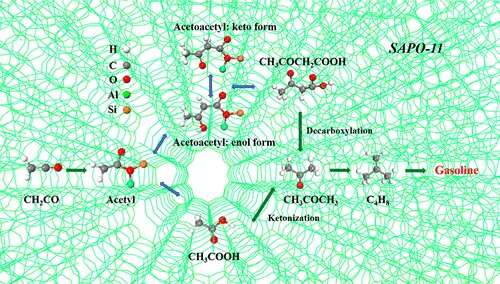Graphical abstract. Credit: Journal of the American Chemical Society (2022). DOI: 10.1021/jacs.2c03478
A joint research team led by Prof. Pan Xiulian, Prof. Bao Xinhe and Prof. Hou Guangjin from the Dalian Institute of Chemical Physics (DICP) of the Chinese Academy of Sciences (CAS) revealed the reaction mechanism of ketene transformation to gasoline on the zeotype H-SAPO-11.
The study was published in Journal of the American Chemical Society on Oct. 3.
In 2016, the team proposed a new catalyst concept based on metal oxide-zeolite bifunctional catalysts and ketene intermediate was detected by highly sensitive synchrotron-based vacuum ultraviolet photoionization mass spectrometry during syngas conversion.
Further studies demonstrated that ketene can be converted to mixed light olefins over molecular zeotype SAPO-34 and transformed to ethene over the eight-membered ring side pocket acid sites of mordenite. Although ketene has also been identified as an important intermediate in other zeolite-catalyzed C1 chemistry, its transformation mechanism is not well understood.
In this study, the researchers studied ketene conversion over H-SAPO-11 employing kinetic analyses, in situ infrared spectroscopy, and solid-state nuclear magnetic resonance spectroscopy.
They found that ketene transformed to butene on the acid sites via either acetyl species following an acetic acid ketonization pathway or acetoacetyl species with keto-enol tautomerism following an acetoacetic acid decarboxylation pathway in the presence of water.
"Our study revealed experimentally for the first time on the reaction network of catalytic ketene conversion over zeotypes and may benefit the further understanding of C1 chemistry," said Prof. Pan.
More information: Yang Zhang et al, Chemistry of Ketene Transformation to Gasoline Catalyzed by H-SAPO-11, Journal of the American Chemical Society (2022). DOI: 10.1021/jacs.2c03478
Journal information: Journal of the American Chemical Society
Provided by Chinese Academy of Sciences
























